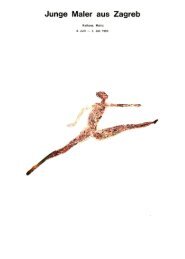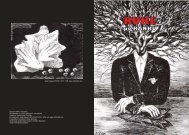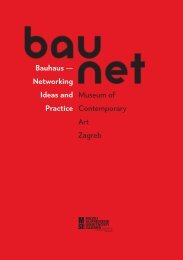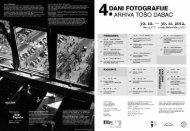Chen Zhen - Muzej suvremene umjetnosti Zagreb
Chen Zhen - Muzej suvremene umjetnosti Zagreb
Chen Zhen - Muzej suvremene umjetnosti Zagreb
You also want an ePaper? Increase the reach of your titles
YUMPU automatically turns print PDFs into web optimized ePapers that Google loves.
J. S. Is that why your installations often have beds and (children's or aduIts') chairs inthem?C. l. The beds and chairs or other objects that l appropriate or transform are elementsthat accompany life. To transform an adult hospital bed into a cradle, a bed into adrum or a lotto box, or a wash tub, all these adaptations are prompted by specific contextsand play with the history of contexts. It is the encounter between a new spaceand its experience that formats my ideas. That is why neither the objects nor the waythey are transformed can be said to define a "style".J. S. In your installation at Albt beds are like spaces of rest for the body and spirit ofobjects, objects that in turn become "internal organs" of the human body, whereas thespace of the centre has become a veritabte garden, and the water a part of the Tamriver. Although everything has been transformed, each of the elements retains its originalidentity, as if they were mirrors reflecting their relations with humankind. Is thisthe spirit in dialogue?C. l. Yes. lt is the very process of art. The transformation takes place in three successivestages: studying the problems, raising questions and developing one's imagination.J. S. Why do your installations often take the form of "initiatory processes'?C.l. Isn't life itself a chain of "initiatory processes"? The way I am living now, alwaysin transit between two countries, between two invitations for exhibitions or residenetes.is a kind of "enchanted dwelUng". I want to use this way of life as a new "structure",a structure that is particularly flexible and open. A life full of challenges to oneselfis another outlook on life, another approach to art.Gradually, this chain of experiences in different contexts triggers productive "shortcircuits" between places and myself, and between different projects. There is not onesingle concept linking all these events. It is the string of life that forms their "logic".J. S. Six Roots, made at the MOCA in <strong>Zagreb</strong>, unites different stages in the cycle of Ilje.Six rooms, six essential stages. Could you shed some light on this notion borrowed fromBuddhism? What are you getting at here?c. l. Six Roots is a Buddhist theme which describes the main senses of our body: Iooking(the eyes), hearing (the ears), smelling (the nose), tasting (the tongue), feeling (thebody) and knowing (consciousness). These essential human capacities link andreflect our various ways of behaving and thinking. These six functions developaccording to cne's age and temperament.Borrowing this Buddhist theme was a pretext for thinking about the "six stages oflife" which reflect and imply contradictory human behaviour. According toBuddhism, these six functions of human development can bring out either the best orthe worst in us.Sl
















